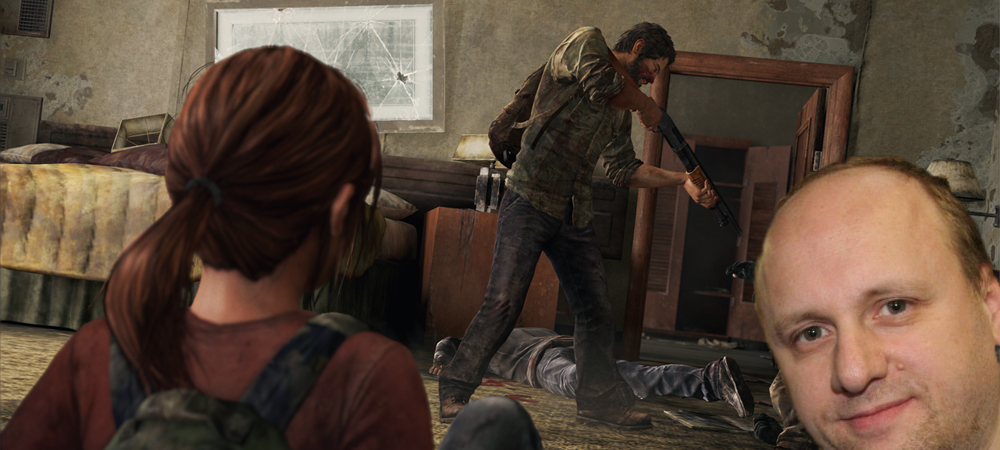On immersion, violence, and the virtual
How is it that a walk around the golf course outside my house, with its scummy pond, ugly ducklings, boring grass, and the dull sky above is so much more immersive than exploring the psychedelic world of Proteus or mystical lands of Journey?
Our perception of reality is guided by our senses. The pavement impacts my feet, the grass crunches as I walk upon it, the sky surrounds my area of vision, and the bayou across the way brings about a strong scent of human feces. I couldn’t be anywhere else, even if I wanted.
If I were to put a gun in my hand and fire aimlessly at the houses, would I become even more immersed in my environment — that is, would I become even more aware and emotionally invested in the current moment? Yes, I would. And so it is with videogames.

The notion of senselessly unloading a fire arm into houses is a distressing one, naturally. It’s also far from a necessity in order to feel attached to my environment and reality, since my senses guide me, even as my mind wanders. And I’m not the least bit schizophrenic (no, really.)
David Cage, and to a lesser extent Warren Spector, gave speeches at D.I.C.E. last week that called for industry action in steering away from violent games and creating ones that reflect our lives and the complexities that come with them: Caring for family, facing familial and employment crises, or simply appreciating the beauty that surrounds us; the subjects we often come across in film and literature.
It’s nothing that hasn’t been said by dozens before — or attempted by many indies — but that these ideas are being delivered from directors of multimillion dollar productions makes these declarations of anti-violence have a special, headline-grabbing impact. After the chin-stroking, blogging, back-patting, and heavy drinking that industry conferences bring, all parties go on their way, acting on market demands at the office while continuing the discussion of ethical theories in private.
I’m not going to explain immersion, the necessity of violence (action), and the future of technology for developers’ benefit; no, this is for the public’s: we suffered too many boring, navel-gazing indie games that are based on the theories that Spector and Cage now preach. The idea of a talented designer following suit with a multimillion dollar project, an edge case should one like it ever exist, is too much to bear.
I am not here to claim Journey didn’t have an emotional impact on me, to call misty-eyed bloggers a bunch of sissypants, or to say we shouldn’t have another game like it. Instead, I wish to focus on why Journey had impact and speculate just how far that impact can go, given the current state of technology.

On immersion: From the Greeks to videogames today, the focus of art has always been on immersion: the ability for a creator to envision a reality and convey it with viewers. Art gives us an escape to another reality, while offering the ability to let us return with renewed strength and insight.
That immersion increased as Greeks evolved from pottery to Hellenistic sculptures that tower above the viewer with lifelike details. And so it was with the theater that gave way to the cinema: A place where sound and vision surrounds the viewer, as increasingly convincing fantasies play out.
And so it is, too, with games. How we have gone from the basic lines of Spacewar! to the complex narrative decisions of Warren Spector’s Deus Ex (though time has indicated it may have been more of Harvey Smith’s Deus Ex that I love so much) in such a short time is one of the most remarkable evolutions of an art form since time began.
So, what makes videogames the most immersive art form, following the logic that pottery -> sculptures/paintings -> plays -> film -> videogames (factoring where novels and music fit is a can of worms I rather not open here)? The most immersive aspect of each art form is embodied in the ones that follow. Plays contain props (pottery) and backdrops (sculptures/paintings); film carry all those and takes out the set and fixed perspective; videogames carry all those and then grants the viewer agency in narrative and interaction in a fictional world, thus granting entrance to devised alternative realities that can be believed through their own logic and rules, so long as they don’t break the ones they previously establish (tsk tsk).

So, there we are then: videogames. If the evolution of art depends on immersion, then how do we make games more immersive? After all, a game of Tetris can be as immersive as a stroll through the lush world of Ni no Kuni or navigating player choices of Dishonored. Immersion can come from mechanics, aesthetics or system-deep narrative interplay.
Like a game of basketball, an intense round of Street Figther or Tetris has a way of dimming the lights on the real world. Taking in the sweeping vistas of Journey makes us temporarily forget there is a controller in the hands. Realizing that choices made hours ago led to a moment unique to one’s playthrough in Dishonored has a way of making a dead reality feel alive.
When a game has all three of these types of immersion, transcendence is achieved, but even this transcendence is only temporary. Cordless or not, the controller and distance to the television serves as a constant reminder that we are only peeking our head below sea level, not quite swimming.

On the necessity of violence: Have you ever played a game where the world is ugly and the gameplay is a chore, yet you feel compelled to continue for the story? But, what about the opposite: A game where the action is all that counts?
Immersion in game world come from our actual senses: touch, sight, and sound. More specifically, immersion in game worlds comes from the combination of all these things, i.e. feedback and sense of possibility (or possibility space). Proteus is more immersive than Dear Esther because the possibility space is larger (not a set path) and feedback is more noticeable (environment reacts to your movement and presence).
How could Proteus be made even more immersive? Violence! Put a gun in the player’s hand, surround the island with threats on legs, and let the code bring the two together. Action has a way of immediately increasing our investment in a game world, since it triggers our reptile brain and makes us focus on a threatening non-reality than the harmless actual reality that our body is inhabiting. If a distinct lack of enjoyment (through faulty programming and design) is present, the illusion is ruined.

Going back to the opening of this essay, violence can make me more aware of my current environment but the power of my senses does that enough. This can also be true of games. Antichamber has no immediate threats — one can argue falling and losing a small amount of progress, I guess, but that’s a stretch — it finds immersion through sight and sound. The abstract architecture overpowers our tendency to compare to reality, and the sound design is rich and ubiquitous. Puzzles, objectives, and first-person movement maintain the immersion. The ability to shoot (action) increases it.
Perhaps it sounds like I’m backpedaling here, but I’m not: Action can exist without violence (harm against another thing), but there is no more immersive action than violence. Would Journey have been a more compelling experience if the player wielded a shotgun and gunned down hordes of enemies? Yes, it would have; but it wouldn’t have maintained the same tone and sense of space. In other words, it wouldn’t have been Journey.
Journey is something of a compromise between immersion and aesthetics. To make the game more immersive through action, it would no longer maintain the same emotional complexity and impact (aesthetics). Journey stands out because its developer focused on feedback and possibility space. The sense of weight, flight, and movement is convincing. The environments are large and freely flowing, expanding while directing the player in slight ways. It’s hard to imagine what can improve the experience without changing its expression.

On the future: I have a lot of admiration for id Software’s John Carmack, but I didn’t expect him to agree with the above. Yet, he did just that when I interviewed him at QuakeCon, last year.
Carmack admitted to making games with guns in first-person because it’s more immersive. Firing a gun introduces possibilities for feedback that are unparalleled in games. I then expected him to tell me how the Oculus Rift VR headset, that he is promoting and tweaking, would further improve this. Instead, he told me how it’d change this, ushering in a new era of non-violent games.
By introducing head-tracking (interaction via touch) and enclosed panoramic HD visuals, a new state of environmental immersion will be introduced, easing pressure off the necessity for action. The Oculus Rift is a baby step toward this future, but the jump from 2D to 3D could also be considered a baby step from where we now stand.
I am not under the impression that the visual impact will be enough to do away with violence and immediate threats in games, but it will open the door for games like Journey that favor expression over immersion (even if not by design) to become more believable. No longer having the world confined to a screen in a living room, or the player’s view fixed (or guided by a camera), will create a more intuitive world; one where the impact from moving may compare to the impact of virtual violence without a VR headset.

Take away the weight of the headset, add realistic body feedback, introduce smell, and you can have realities that are virtual in name only. It’s a frightening Snow Crash future that may exist in a Mad Max world, but that’s the only way games will be able to tell stories of emotional impact without relying on violence.
In a way, film and novels are still more immersive than games, since they carry a greater level of immersion to more kinds of stories. Recreate episodes of Mad Men or a great novel in a videogame world and you’d be bored silly. Our mind and senses guide us through art; our bodies occupying an almost catatonic state. This state, however, cannot be reached with games that require us to push buttons and fiddle with thumbsticks — things we cannot do without thinking about them. And putting the controller aside for cutscenes forsakes the medium (sorry, Walking Dead).
Dear David Cage: Dreaming of games without violence is a lofty goal. One that we may achieve in the near future. But, before we tell the masses that it’s time to do away with violence, we must wait for technology to catch up to artistic expression, first, through new and improved ways of interacting with our senses.
For now, let’s get emotional with our fists.




